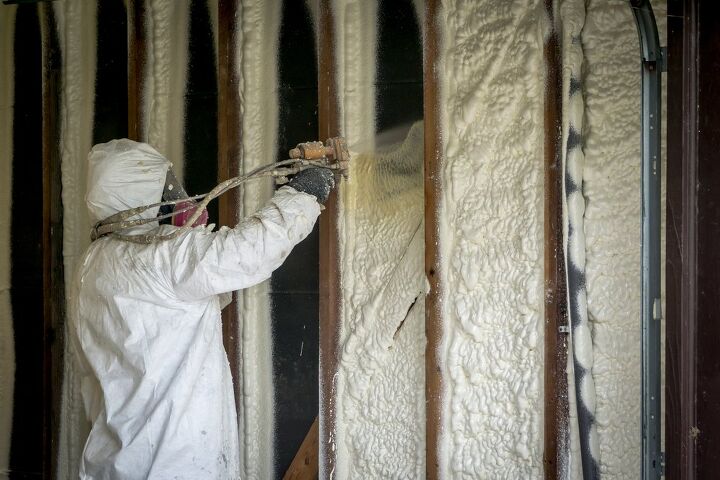Spray Foam Insulation Vs. Fiberglass: What Are The Major Differences?

Insulation in your home is crucial for temperature control. When you have inadequate insulation, your HVAC has to work that much harder to do its job. The harder it works, the more costly your energy bills wind up being and the lesser life your HVAC system has.
When it comes to insulation, you will find that there are a wide array of choices out there. Two of the most common are spray foam and fiberglass. But what is the difference? The biggest difference is in the application. Spray foam is just as it sounds: it sprays into the crevices of your walls, filling in all the gaps. Fiberglass, meanwhile, comes in big rolls which are then cut into sheets for application.
Do You Need Insulation Installers?
Get free, zero-commitment quotes from pro contractors near you.

What is Fiberglass Insulation?
As you get started comparing insulation types, you may find that there is a major difference between the various offerings. When it comes to fiberglass versus spray foam, there is a huge difference and that is in the application.
Fiberglass insulation generally comes in thick rolls or sheets. It is constructed of fibrous materials known as batts. Fiberglass was commonly used in older constructions throughout the United States because of its affordability.
There are tons of tiny fibers of glass within the sheets. This barrier is what keeps air from flowing through it. Throughout the years, the effectiveness of fiberglass insulation has begun to wane, which is why other options are becoming more popular.
What is Spray Foam Insulation?
If the name wasn’t a dead giveaway, this is a kind of insulation that sprays on as compared to the sheets of fiberglass. There are also two different kinds of spray foam: open and closed cell. Both are effective but do different things.
Closed air blocks air off completely. That means better control over internal temperatures in a building or home. Open cell spray foam is a bit more cost-effective as it lets some airflow through. That’s not to say it isn’t efficient, it just isn’t as efficient as closed cell.
Spray foam is made up of a polymer that, when applied, begins to expand. Closed cell will harden as it dries, allowing it to block out airflow. Open cell remains soft, absorbing the air as it tries to pass through the insulation.
Closed vs. Open Cell Spray Foam Insulation
While there is only one kind of fiberglass insulation to choose from, you can go one of two routes with spray foam insulation. That would be closed cell or open cell insulation. There are differences between the two despite a similar installation method.
Open cell insulation dries soft and works by absorbing air as it flows into the insulation. Open cell spray foam is the cheaper of the two because it is not quite as efficient as the closed cell option. That said, it makes for a highly effective option and also offers sound reduction qualities.
Closed cell, meanwhile, dries hard. Instead of absorbing the airflow, closed cell spray foam blocks out airflow entirely. It is the most efficient type of insulation for homes that there is. Which also makes it great for sound reduction and even for reducing dust and dirt that can aggravate allergies.
Spray Foam Insulation vs. Fiberglass: A Comparison
Now that we know what each type is and its basic function, it is time to compare the two in a variety of ways. The most important factors are going to be cost, length of life, efficiency, fire hazards, and any allergy considerations from their use.
Length of Life
Durability is right there alongside efficiency in terms of overall importance in terms of insulation. Fiberglass, when it was one of the most popular options out there, was considered durable. It can last decades but it does lose some of its effectiveness as it gets older. Moisture that is present can also degrade the effectiveness of fiberglass insulation.
Spray foam, on the other hand, can last 80 years and even longer. Spray foam is far more permanent of a solution and a more effective one at that.
Sure, you pay more upfront, but you are paying for durability and longevity. The clear advantage in length of life goes to spray foam insulation. Spray foam insulation is durable and will dry out when it gets wet.
Cost
One of the most relevant factors when choosing an insulation. When you buy fiberglass insulation, you are paying by the square foot. You can determine how much your installation costs will be based on square footage and the R-value that you need to achieve.
Spray foam, on the other hand, is paid for by board foot. A board foot is one foot wide, one foot long, and one inch thick. So, covering 1,000 square feet of 3” closed cell spray foam would equate to about 3,000 square feet.
A single board foot of closed cell spray foam can run you anywhere from double to triple the cost of a square foot of fiberglass insulation. The reason being that it is not only much more durable but much more efficient at keeping airflow and moisture out.
Efficiency
Aside from the cost, this may be where the biggest discrepancy is between fiberglass insulation and spray foam insulation. Fiberglass is cheaper to install for a few reasons, one of which is its overall longevity and efficiency.
Fiberglass wears down over time, losing its efficiency throughout the years. The less efficient it becomes, the more airflow that can enter your home. This can lead to increased utility costs over the life of the fiberglass.
Spray foam in both forms is far more efficient compared to fiberglass. Even comparing the two, closed cell is more efficient than open cell. The latter absorbs some of the air as it enters your home whereas the former completely blocks out airflow. You should notice serious savings on utilities over the lifespan of your spray foam insulation.
Fire Hazards
One aspect of insulation that does not get talked about enough is the potential flammability of insulation. The simple fact is that both options can be flammable in certain situations. There is one major difference between the two.
You can add an intumescent paint to your spray foam. You will need to apply it on a regular basis but it does provide a 15-minute thermal barrier. That 15 minutes can make a huge difference when it comes to a fire in your home.
Most local codes require that you cover your spray foam insulation.
Allergy and Sound Considerations
Finally, you want to consider the implications in terms of both sound let in and impact on allergies. Fiberglass insulation is able to block a little bit of sound but it is far from the best option on the market. Not to mention the fact that fiberglass insulation can also raze allergies in a serious way.
It won’t surprise you to know that spray foam insulation is also better at blocking out sound. So, if you value your quiet, then spray foam is the superior option. On top of that, spray foam insulation is also capable of blocking out dust and pollen. That means it is very friendly to those who have allergies.
Cost Does Matter
If you have made it this far, you know that there is a clearly better option between the two types of insulation. The disparity is almost so great that one may wonder why there is even a choice between the two. The simple answer is cost.
Cost does matter and so do budgets. As much as we would all love to spend on the best of the best, that may not be feasible. And the simplest explanation for why people choose fiberglass insulation, a clearly inferior product, is because of the costs.
The average cost to have spray foam insulation installed is roughly $0.44 to $0.65 per board foot for open cell and $1 to $1.50 per board foot for closed cell. That means anywhere from $1,300 to nearly $4,000 to have 1,600 square feet covered.
On the other hand, fiberglass insulation is substantially cheaper. For that same area, you are looking at a few hundred bucks for the installation. So, while it is clear that spray foam is superior in every way, it can be difficult to overlook the vast difference in installation price.
Do You Need Insulation Installers?
Get free, zero-commitment quotes from pro contractors near you.

Which is the Better Choice?
When you compare fiberglass insulation to spray foam insulation, it is clear that there is one superior choice. That is spray foam insulation in every single way.
Spray foam lasts a lot longer; up to 80 years. No matter whether you go with open or closed cell spray foam, it is more efficient than fiberglass insulation. Not to mention the fact that spray foam is better at keeping out sound and allergies.
Fiberglass insulation is fine for what it is and is great for those who are on a budget. Spray foam can cost quite a bit more than fiberglass insulation and cost is the primary reason why homeowners choose fiberglass.
But if you can spare the additional costs, it is clear that spray foam is the vastly superior option. If you can spare the costs, spray foam insulation should be the choice for nearly every reason there is.

Ryan Womeldorf has more than a decade of experience writing. He loves to blog about construction, plumbing, and other home topics. Ryan also loves hockey and a lifelong Buffalo sports fan.
More by Ryan Womeldorf













![10 Best Electric Pressure Washers – [2022 Reviews & Guide]](https://cdn-fastly.upgradedhome.com/media/2023/07/31/9070600/10-best-electric-pressure-washers-2022-reviews-guide.jpg?size=350x220)







![12 Washing Machine Brands to Avoid [with Recall Data]](https://cdn-fastly.upgradedhome.com/media/2023/07/31/9075781/12-washing-machine-brands-to-avoid-with-recall-data.jpg?size=350x220)





